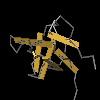?
 
First Src Homology 3 domain of Nck1 adaptor protein Nck1 (also called Nckalpha) plays a crucial role in connecting signaling pathways of tyrosine kinase receptors and important effectors in actin dynamics and cytoskeletal remodeling. It binds and activates RasGAP, resulting in the downregulation of Ras. It is also involved in the signaling of endothilin-mediated inhibition of cell migration. Nck adaptor proteins regulate actin cytoskeleton dynamics by linking proline-rich effector molecules to protein tyrosine kinases and phosphorylated signaling intermediates. They contain three SH3 domains and a C-terminal SH2 domain. They function downstream of the PDGFbeta receptor and are involved in Rho GTPase signaling and actin dynamics. Vertebrates contain two Nck adaptor proteins: Nck1 (also called Nckalpha) and Nck2, which show partly overlapping functions but also bind distinct targets. The first SH3 domain of Nck1 binds the PxxDY sequence in the CD3e cytoplasmic tail; this binding inhibits phosphorylation by Src kinases, resulting in the downregulation of TCR surface expression. SH3 domains are protein interaction domains that usually bind to proline-rich ligands with moderate affinity and selectivity, preferentially a PxxP motif. They play versatile and diverse roles in the cell including the regulation of enzymes, changing the subcellular localization of signaling pathway components, and mediating the formation of multiprotein complex assemblies. |
